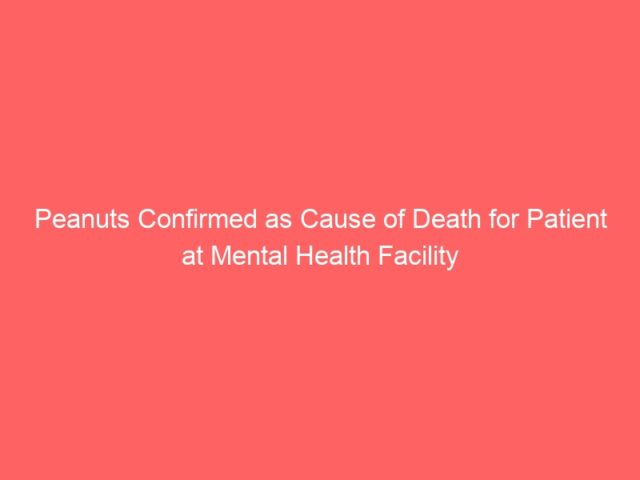[Trigger Warning]
A New Zealand mom has referred to as her son’s dying a “mindless waste of a life” after a autopsy confirmed the 24-year-old died from an allergic response attributable to hint quantities of peanut in a meal at a psychological well being respite facility. Riley Brown, a affected person on the Nelson facility operated by supplier Pathways, suffered deadly anaphylaxis on June 1. His dying has led to a proper assessment by Well being New Zealand into the care he acquired, following the affirmation that his recognized peanut allergy brought about his tragic passing.
The autopsy, carried out by pathologist Dr Mark Houghton, confirmed Brown’s reason behind dying was anaphylaxis triggered by a peanut allergy. Notably, a toxicology report on the meals Brown ate revealed traces of a peanut allergen — 594.9 elements per million. The report famous this stage “exceed[s] each the relevant regulatory thresholds and the standard concentrations anticipated in merchandise labelled as free from peanut allergens,” confirming that an ingredient in his meal contained the lethal contaminant.
Riley’s mom, Paula Brown, acquired the autopsy and toxicology reviews from the Coroner’s Court docket and expressed her horror on the findings, stating she had a “intestine feeling” her son’s meal contained nuts, regardless of earlier assurances on the contrary. Upon studying the paperwork, she was “horrified” and demanded accountability for the systemic failure. She said emphatically, “I would like them to be made accountable for this, to take accountability.”
The pathologist’s report additionally contained particulars on potential complicating components, together with the presence of a number of drugs. Houghton confirmed Brown’s elevated serum tryptase stage of 32.3 micrograms per liter was “in line with anaphylaxis.” The report additionally famous the presence of propranolol, a beta-blocker, which “had been reported to dam or restrict the results of adrenaline [epinephrine] as a therapy for acute anaphylaxis.” Regardless of this, Houghton confirmed, “On this case, intramuscular adrenaline was delivered quickly and appropriately with restricted medical impact.”
Particulars of the night of June 1 reveal a swift and finally deadly development of the allergic response. Two hours after having dinner on the facility, Riley Brown started to really feel unwell, believing he was having an allergic response. At 7:20PM, the ambulance was dispatched on a “non-urgent” job for a extreme allergic response. In keeping with the ambulance abstract, Brown was capable of stroll to the car “saying he couldn’t breathe” however died shortly after at 8:15PM, reportedly going into cardiac arrest whereas being transferred to the hospital.
For Paula Brown, the grief stays overwhelming 4 months after her loss. She described the profound private toll of her son’s dying, telling reporters that she was “struggling to get on with life.” She poignantly expressed how central her son was to her life, saying, “Riley was my life,” and lamented, “It’s taken Riley’s life and has destroyed mine.”
In response to the confirmed reason behind dying, Well being New Zealand Regional Lead Vicki Dent provided the group’s “deepest sympathies and heartfelt condolences” and confirmed a assessment of the care supplied is underway. Psychological Well being Minister Matt Doocey additionally weighed in, saying his ideas had been with the household, and acknowledging, “The loss of a kid is each guardian’s worst nightmare.” He added a transparent expectation for the service, stating, “I anticipate that anybody underneath the care of New Zealand’s psychological well being providers is supplied with secure, high-quality care, and the assessment should look at whether or not that customary was met.”
We provide our honest condolences to Ms. Brown, who’s experiencing each guardian’s worst nightmare.
It’s fully unacceptable for a facility liable for somebody’s care to neglect its duties by poisoning them with their allergen. We anticipate Pathways to be held accountable and for system-wide modifications to be applied to stop this from ever occurring once more.
Though epinephrine was administered earlier than Mr Brown was taken to the hospital, it was evidently not sufficient to cease the development of anaphylaxis. Though we don’t know if he was given a second dose, we hope that is investigated.
It’s crucial for everybody who has been prescribed epinephrine to take two doses alongside in all places, each time, and to manage the primary dose when anaphylaxis is first suspected. If signs persist after 5 to fifteen minutes, administer the second dose and name emergency providers.
If you’re taking a beta blocker like propranolol, focus on the way it may have an effect on the effectiveness of epinephrine together with your doctor.













